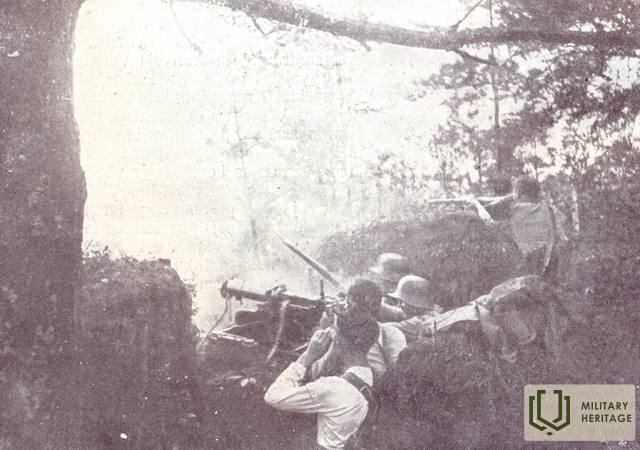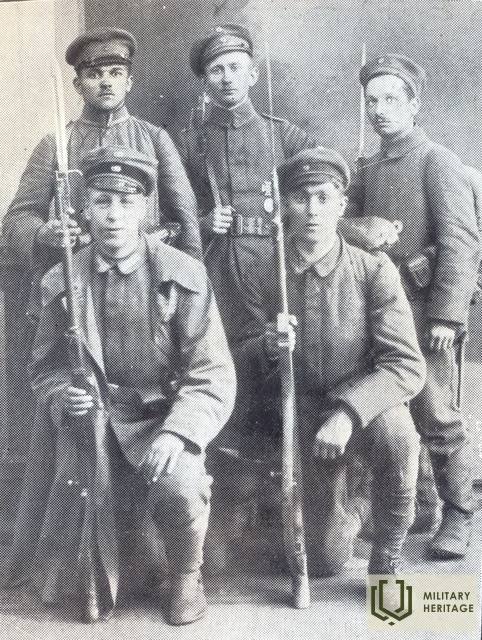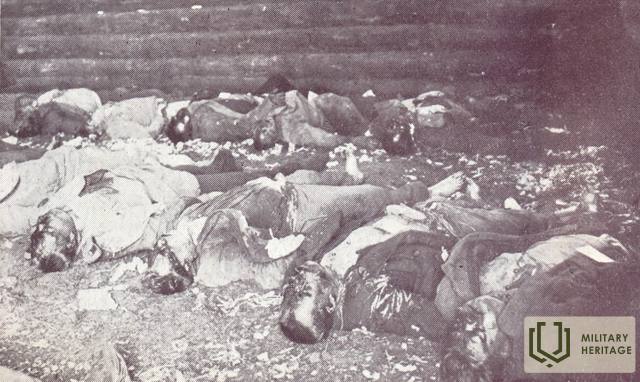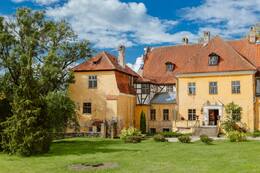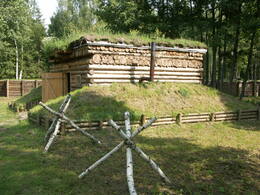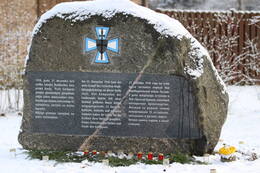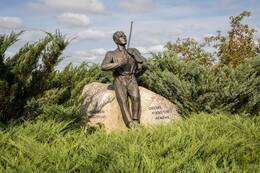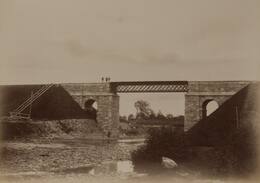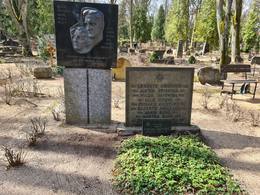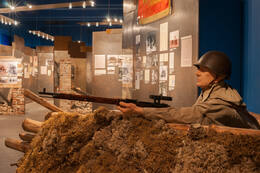Landesveras. Baltijos Landesveras
I Nepriklausomybės karai
Landesveras. Baltijos šalių sausumos gynyba (vok. Baltische Landeswehr, rus. Балтийский ландесвер, angl. Baltic Land Defence, Baltic Territorial Army, Baltic Home Guard)
Baltijos Landesveras buvo vokiečių okupuotų Baltijos gubernijų gyventojų savigynos struktūra, kurios parengiamieji darbai prasidėjo 1918 m. ankstyvą rudenį, tačiau lapkričio antroje pusėje buvo įtrauktas į naujai įkurtos Latvijos Respublikos ginkluotąsias pajėgas – Latvijos žemės gvardiją (vok. die Lettländische Landeshrweeshrwe, kitaip vadinama Collländische Landeshrweeshrwe).
Daugiatautė (baltų vokiečiai, latviai, rusai) „Latvijos nacionalinė gvardija“, su vokiečių karine parama, tapo Latvijos ginkluotosiomis pajėgomis. Administraciniu požiūriu ji buvo pavaldus Latvijos gynybos ministrui Jāniui Zālīčiui, o logistikos ir karinių operacijų atžvilgiu – vokiečių okupacinių pajėgų vadovybei. Latvijos vyriausybės ir Vokietijos atstovo Augusto Vinnigo susitarime buvo numatyta savanoriškai formuoti krašto gvardiją iš 18 latvių, 7 vokiečių ir vienos Rusijos kuopos Pagal pirminį planą nacionalinės gvardijos vadu turėjo būti neutralios šalies (Švedijos) atstovas, tačiau tai neįvyko. Vinnigas jau lapkričio pabaigoje iš išvykstančių vokiečių kariuomenės karių buvo suformavęs Geležinę brigadą (vėliau Geležinę diviziją), kurios kariai po gruodžio mėnesio susitarimo turėjo galimybę gauti Latvijos pilietybę ir žemę.
Vokiečiai ir baltvokiečiai kariuomenę ir toliau vadino Baltijos landesveru, o ne latvių Landesgaardu. Latvių kuopos, pradėjusios kurtis Landesvero ribose, pavadinimus kildino iš kūrimosi vietos (Ryga, Cėsis, Jelgava, Latgala) arba kompozicijos (Karininkai, Studentai) pavadinimo. Latvių dalinių vadu buvo paskirtas pulkininkas leitenantas Oskars Kalpaks.
Vasario pradžioje į Liepoją atvyko generolas Rüdiger von der Goltz. Jis buvo paskirtas Vokietijos ginkluotųjų pajėgų (į kurią buvo įtrauktas Baltijos Landesveras ir Geležinė divizija) Kuršėje ir Šiaurės Lietuvoje vadu, Liepojos gubernatoriumi. 1919 m. balandžio 16 d. Golcui pavaldūs kariuomenės daliniai Liepojoje įvykdė perversmą prieš Latvijos laikinąją vyriausybę.
Į Baltijos landesverą susivieniję Baltijos vokiečiai įvairiais Nepriklausomybės karo etapais ir rėmė Latvijos liaudies tarybos įsteigtą Laikinąją vyriausybę, vadovaujamą Kārlio Ulmanio, ir prieš ją kovojo, kai stojo į nelegalią Andrievo Niedros vyriausybę. Jei iš pradžių tiek vokiečių, tiek latvių daliniai turėjo bendrą tikslą – išvaduoti Latviją nuo bolševikų, 1919 m. gegužę išlaisvinus Rygą, Landesvero ir Vokietijos Geležinės divizijos karinės operacijos buvo nukreiptos ne prieš bolševikus, o prieš Šiaurės Latvijos kariuomenę ir teisėtai Latvijos laikinajai valdžiai lojalią Estijos kariuomenę. Po Cėsių mūšio, kuriame buvo sumuštas Landesveras ir Geležinė divizija, Latvijos valstybei ištikimi landesvero daliniai tęsė kovą su bolševikais. 1920 03 30 Landesveras buvo pertvarkytas į 13-ąjį Tukumo pėstininkų pulką ir įtrauktas į Kuršo diviziją. 1922 04 01 pulkas buvo išformuotas, kariai įtraukti į 7-ąjį Siguldos pėstininkų pulką.
Žymiausi Landesvero vadai buvo Alfredas Flečeris (1919 m. vasario 1 d.–1919 m. liepos 12 d.) ir Haroldas Aleksandras (1919 m. liepos 12 d.–1920 m. vasario 18 d.).
Daugiau informacijos šaltinių
Erikas Jacobsonas. Latvijos nepriklausomybės karas. Latvijos laikinosios vyriausybės ir jos ginkluotųjų pajėgų kova dėl Latvijos nepriklausomybės nuo 1918 11 18 iki 1920 08 11. – Nacionalinė enciklopedija: https://enciklopedija.lv/skirklis/22216-Latvijas-Neatkar%C4%ABbas-kar%C5%A1
Laisvės kova: Latvijos nepriklausomybės karas (1918–1920) Latvijos valstybės istorijos archyvo dokumentuose, 1 dalis, 1918–1919 lapkričio 18 d. 2016 m. balandžio 16 d., kompl. E. Jēkabsons ir J. Šiliņš, Ryga, Latvijos nacionalinis archyvas, 2019 m.
„Kova už laisvę: Latvijos nepriklausomybės karas (1918–1920) Latvijos valstybės istorijos archyvo dokumentuose“ 2 dalis. 1919 m. balandžio 16 d.–liepos 10 d., Ēkabsons ir J. Šiliņš, Ryga, Latvijos nacionalinis archyvas, 2019 m.
Latvijos laisvės kova (žr. literatūrą ir išorines nuorodas). Vikipedijos puslapis: https://lv.wikipedia.org/wiki/Latvijas_br%C4%ABv%C4%ABbas_c%C4%AB%C5%86as
Susijusi laiko juosta
Susijusios vietos
The monument commemorates the Carnikavans shot in 1919 by Landeswehr
It is located in the SW corner of Carnikava Park at the intersection of Jūras Street and Nākotnes Street between two oak trees.
A granite monument to 12 Carnicavians who were killed by German Landeswehr units in the spring of 1919 for allegedly visiting the "red group".
Lielstraupe Castle
The Lielstraupe Castle is located in the centre of the town of Straupe. The castle is open to visitors and offers a journey through the centuries along with an orienteering exercise in the labyrinths of the castle. During the Battles of Cēsis, the Lielstraupe Castle housed the command post of Paul Ludwig Ewald von Kleist’s Battle Group of the Iron Division (German: Eiserne Division). During the battles, the castle was visited by Major Josef Bischoff, Captain Heinz Guderian and others. The castle was used for the coordination of an attack in the direction of Stalbe on 21-22 June. The Iron Division was a military force of German mercenaries during the Latvian War of Independence, which was formed from soldiers of the 8th Army of the demobilised German Empire and volunteer mercenaries. It was the best-known part of the German Free Corps and among the best trained and most combat-ready military forces in the Baltics in 1919. During the Soviet period, from 1949 to 1959, the administration of the Lielstraupe Machine-tractor Station operated out of Manor Castle. During this time, the castle was also equipped with training rooms and dormitories for tractor drivers, while the former stable of the manor housed workshops. From 1963 to 2018, the castle was managed by medical institutions, and it was said of the Straupe Narcological Hospital in Latvia that it ‘even treats the walls’.
Kalėdų mūšių muziejus
Muziejus, įsikūręs sodyboje „Mangaļi“ Jelgavos apylinkėse, Valgundės seniūnijoje, yra Latvijos karo muziejaus filialas. Jis atidarytas 2005 m. toje vietoje, kurioje per Pirmąjį pa saulinį karą vyko Kalėdų mūšiai. Šiose vietose iki šiol tebėra išlikę išskirtiniai Pirmojo pasaulinio karo įtvirtinimai. Kalėdų mūšių muziejaus ekspozicija yra įrengta autentiškoje vieto je po atviru dangumi. Čia galima pamatyti rekonstruotą įtvirtinimų sistemos fragmentą – lauko slėptuvę ir dalį pir mosios vokiečių gynybos linijos, vadinamos „vokiečių pyli mu“. Tai vienintelis tokio pobūdžio objektas Baltijos šalyse. Kalėdų mūšiai – vienas žinomiausių ir dramatiškiausių Pir mojo pasaulinio karo įvykių Latvijoje. Jie užima ypatingą vietą latvių karo ir kultūros istorijoje. Intensyvūs mūšiai truko šešias dienos ir pareikalavo daug aukų. Šie įvykiai dažniau siai siejami su latvių šaulių puolimu prieš Vokietijos kariuo menę, vykusiu ypač atšiauriomis ir nepalankiomis žiemos sąlygomis. Tai buvo pirmas kartas, kai didelio masto puo limas vyko be artilerijos palaikymo. Šiuo metu muziejuje eksponuojami mūšių vietose rasti radi niai. Vidaus ekspozicija lankoma nustatytu laiku, o po atvi ru dangumi esančių įtvirtinimų ekspoziciją galima apžiūrėti kiekvieną dieną. Apylinkėse sudaryti turistiniai maršrutai ir įrengti pažintiniai takai.
Monument to the first battle for Latvia's independence
Atroadas, Inčukalns, Atmodas Street 2.
On July 3, 2016, a monument to the first battle for Latvia's independence, dedicated to the Latvian National Guard (Die Lettländische Landeswehr), was unveiled. sides. Eižens Upmanis, the chairman of the Brothers' Cemetery Committee, concluded at the time that this could be the historically first monument to the combined Latvian and Baltic forces in the battle memorials outside the cemetery. At that time, Lieutenant Colonel Oskars Kalpaks was appointed commander of the Latvian units of the Latvian National Guard or Landesver, from whose units the later Latvian army grew and formed during the Freedom Fights.
In 1918, the entire territory of present-day Latvia had fallen into the hands of the German Empire and its troops. However, at the end of the summer and autumn of 1918, the situation began to end badly for Germany, and it was clear that it was only a matter of time before Germany would be forced to concede defeat in World War I. The Russian Empire, which included Latvia before World War I, had ceased to exist earlier, with the revolutions of February and October 1917. On November 18, 1918, the Republic of Latvia was proclaimed. After the ceasefire with the Entente on November 11, 1918, the German army, which was on the territory of Latvia, was no longer motivated for further warfare, and most of its soldiers simply wanted to return home.
Under such circumstances, it was clear that Latvia's defense depended primarily on the national guard formed by the people of Latvia. Initially, due to their education and relatively greater ability to self-organize, the greatest initiative in creating such a national guard was shown by the Baltic Germans living in Latvia. Russian soldiers also joined the National Guard. In order to ensure the supply of the National Guard with uniforms, weapons and other necessary resources, on December 7, 1918, the Provisional Government of Latvia entered into an agreement with the German representative August Vinnig, providing for the provision of the National Guard from the German army reserves in Latvia. This agreement stated, among other things, that the National Guard, officially known as the Latvian National Guard or in German, the die Lettländische Landeswehr, would be the armed forces of the Republic of Latvia.
Two soldiers of the Latvian Red Rifle Regiment (ie approximately 2,000 to 3,000 soldiers) who had previously experienced in World War I and the Russian Civil War faced the Latvian National Guard. Despite the experience and numerical superiority of the Red Army, the Latvian National Guard held Inčukalns for two days in fierce fighting, until finally, in the evening of January 1, 1919, to avoid siege, was forced to retire, losing 43 dead and several wounded, most of whom was taken captive by the Bolsheviks, where they were killed or died of starvation or disease.
Author: Artis Buks. Material: Boulder. The monument is made of large monolithic stone, which was found in Rolls near Jelgava.
The birthplace of Colonel Oskars Kalpaks “Liepsalas” and the final resting place in Visagals cemetery
The Colonel Oskars Kalpaks family memorial in Liepsalas is located in the area between Madona and Lake Lubāns. Liepsalas is Kalpaks’ childhood home. The memorial site was established here in 1997 based on the ideas and using the resources of the colonel’s niece, Ārija Kalpaks-Grundmane (1922-2006). The site consists of various environmental objects and stone sculptures with a symbolic meaning, signifying Latvian ethical and patriotic values. The largest building houses an exhibit dedicated to the history of the Latvian War of Independence and the 22 years of Latvian freedom (1918-1940). Located in the Visagals graveyard, the monument to Oskars Kalpaks, created by Kārlis Zāle and Arnolds Dzirkals, was unveiled in 1927. The monument consists of a composition of three figures, in the centre of which is an ancient Latvian warrior holding a shield and a sword, with a falling soldier on each side. Placed obliquely on a granite base, a bronze plaque at the foot of the sculptural group contains engraved text, including a poem, dedicated to Kalpaks, by Edvards Virza. Oskars Kalpaks died on 6 March 1919 near Airītes, by the road from Skrunda to Saldus.
Railway bridge over Amata
Located in Drabešu parish, Cēsis region, near the recreation place "Meža kaujas".
There is a railway bridge over Amata.
The railway bridge over Amata played a very important role throughout the War of Independence, because on June 5, 1919, the first battle of the Estonian army's armed trains with the Baltic Landesver units took place here. Landeswehr, knowing that an armed train was approaching, nominated a railway bridge and took a position at the Amatas home on the river bank, ready for possible warfare. The bridge over Amata was the border between Estonian forces and the Germans.
Historical evidence of the events at the Amata Bridge has not been preserved. As Latvians did not take part in these events, there are no narratives of their memories, there are memories from Estonian soldiers and other sources. It can be said that this was an Estonian-American joint battle against the Landeswehr, because there was an American officer on the Estonian armored train, who later fought in World War II as well. In general, many future World War II officers and commanders took part in the battles of Cēsis, especially on the German side.
The Estonian armed train arrived in Cēsis on June 2, 1919, a day later went to Ieriķi, where talks took place with the landlord, which was unsuccessful, and on June 5, when the armed train approached the Amata bridge again, a collision with the Germans began. A day later, the armed train also took part in the battles near Cēsis, where it helped the soldiers of the Pupils' Company who were threatened with siege. Although the Germans tried to dismantle the rails to cut off the train's retreat, it managed to retreat across the Rauna bridge.
On the night of June 23, 1919, during the battles of Cēsis, the landesver left Cēsis and retreated to the Amata river line. When they retreated, the Germans burned down the house of the Cēsis Latvian Society and blew up a bridge over Amata.
Monument to the first fallen soldier of the Schoolmen's Company, Edgars Krieviņas
Located in the Central Cemetery of Valmiera, near the chapel (Miera Street 1/3, Valmiera)
A soldier of the 8th (Skolnieki) company of the Cēsi regiment, LKOK Edgars Krieviņš (1899-1919), died on June 7 from injuries sustained in the battles of Cēsi on June 6, 1919, when he covered the retreat of the rest of the units when the Landsweer attacked.
Latvian War Museum
The Latvian War Museum is located in the Old Town not far from the Freedom Monument in a historic defence building called the ‘Powder Tower’. There are 11 exhibits in the museum. There are various weapons, documents, uniforms, awards, badges and other items detailing the everyday life of a soldier in war. The Latvian War Museum is one of the oldest museums in Latvia. Its origins can be found in World War I. Museum’s collection was made up mainly of personal items of soldiers or items found on battlefields. After Latvia gained its independence the main goal of the museum became to create an exposition on the military history of Latvia and the active role of the population in protecting their land. In 1937 the museum was expanded and was technically one of the most modern museums in Europe at that time. The Powder Tower was one of the fortification towers of Riga. Some evidence dates back to 1330 where it has been mentioned as the ‘Sand Tower’. The tower was destroyed in 1621 when Riga was besieged by the Swedish Army. But in 1650 a new tower for storing gunpowder and weapons was built. After the city’s fortifications were taken down, the Powder Tower remains as one of the most important pieces of evidence of the Riga defence system.
Susijusi istorija
Cėsių mūšio pradžia, eiga ir pabaiga
Pergalei Cėsių mūšyje buvo lemta tapti lūžiu latvių ir estų kovoje už savo šalies nepriklausomybę. Ši pergalė padarė tašką Andrievo Niedros vyriausybės ir vokiečių generolo Rüdigerio von der Goltzo planams užkariauti Baltijos šalis. Vietoj to Liepojoje savo veiklą atnaujino Laikinoji Latvijos vyriausybė, vadovaujama Kārlio Ulmanio.
Apie tautos patriotą pirmąjį leitenantą Vilį Gelbį
Pulkininko leitenanto Vilio Gelbės (1890-1919) likimas atspindi sunkią mūsų valstybės ir kariuomenės formavimosi situaciją bei šių įvykių vertinimą.
1918 m. lapkričio 18 d. paskelbus Latvijos valstybę, prasidėjo ir jos Nepriklausomybės karas bei ginkluotųjų pajėgų kūrimo darbai. Latvių karių savanorių priešakyje buvo Kuržemėje gimęs karinio jūrų laivyno leitenantas Vilis Gelbė.
Aizpori dvaras Nepriklausomybės kare
Aizporu pusdvaras, Aizputės rajonas, Kalvenės savivaldybė, yra labiausiai į vakarus nutolusi Latvijos vieta, į kurią traukėsi pulkininko Oskaro Kalpako atskirasis batalionas.
Pusiaukelėje tarp Rudbāržių ir Kalvenės, kelio pusėje, yra Aizporės kapinės. Yra paminklas ir 12 memorialų Oskaro Kalpakos bataliono kariams savanoriams.




